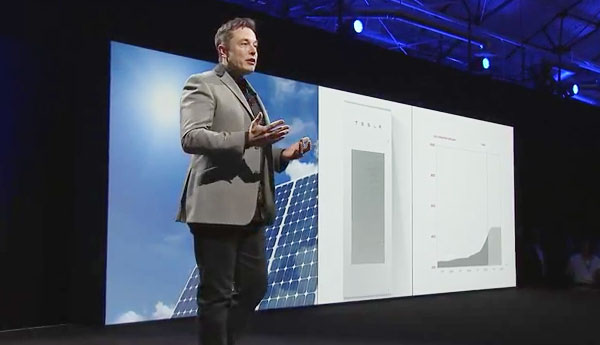Tesla Motors on Monday announced that it has reached an agreement to purchase SolarCity. The deal could create the world’s first vertically integrated sustainable energy company.
The merger would drive efforts to develop rooftop solar systems, and better storage batteries for homes and businesses, as well as electric vehicles. It would, in essence, tie together Elon Musk’s sustainable energy businesses.
The purchase of SolarCity would be an all-stock transaction with an equity value of US$2.6 billion, based on the five-day volume-weighted average price of Tesla shares, according to Tesla.
Under the terms of the agreement, which the independent members of both companies’ boards approved, SolarCity stockholders would receive 0.110 Tesla common shares per SolarCity share.
Per the terms of the agreement, SolarCity has a 45-day “go-shop” period, during which it can solicit alternative proposals, Tesla said.
Musk, who last month announced Tesla’s intention to make the acquisition, already owns about 21 percent of SolarCity and currently sits as its chairman. Musk’s cousin, Lyndon R. Rive, is SolarCity’s CEO, and another cousin, Peter J. Rive, is the company’s CTO.
SolarCity’s stock price fell in Monday morning trading to $25.06, down about 6.2 percent. Tesla shares were down 0.7 percent to $233.21.
Sustainable World
The combined efforts of the two companies could help Musk follow through on the updated master plan he unveiled last month.
“From Elon Musk’s point of view, his ultimate goal has always been to change the way we generate and consume energy,” said Kevin Krewell, principal analyst at Tirias Research.
“By integrating Solar City into Tesla, he can vertically integrate that process,” he told the E-Commerce Times.
The long-term goals are evident, notably with the introduction last year of the Powerwall battery pack, which was “one of the key technologies that allow homes to store the solar power for night use and can make the home mostly energy self sufficient,” noted Krewell. “Musk now feels that Tesla is strong enough to take on SolarCity, making the energy integration cycle complete.”
The Tesla Drive
One of the biggest takeaways from this deal could be Tesla’s evolution from being an electric car maker toward becoming a leader in sustainable energy.
“As the company expands into renewable energy, the automotive revenues could become a minority share,” suggested Cosmin Laslau, senior analyst at Lux Research.
“Under the new Tesla umbrella, there could be vehicles, panels and energy storage as the three main components, as well as car sharing and other aspects that fit with Musk’s master plan,” he told the E-Commerce Times.
This acquisition brings Tesla one step closer to becoming an energy company, added Frost& Sullivan mobility research manager Vishwas Shankar.
This could mean cross-selling SolarCity’s offerings to Tesla Motors’ customers. Both brands could grow simultaneously, he told the E-Commerce Times. “What SolarCity brings to the table is interesting; existing SolarCity customers could potentially get a taste of Tesla Motors in the near future.”
Broader Picture
Selling high-end electric vehicles was just a way to develop a revenue stream that eventually would allow the production of cars for the mass market, Musk noted in detailing the company’s master plan. It also would foster acceptance of renewable energy. It seems as though the SolarCity acquisition would further that plan.
“Tesla is very mission-oriented, and profit is only part of that mission,” said Stephanie Brinley, senior analyst at IHS Automotive.
“The bigger priority is about getting the industry to think differently about renewable energy,” she told the E-Commerce Times. “Vehicles are just part of it, and this is not a short-term vision either.”
For Tesla to accomplish its goals, SolarCity could end up being the key, rather than a secondary component.
“SolarCity is a more stable business than Tesla Motors, owing to its wide customer base that continues to grow,” suggested Frost’s Shankar.
The merger would afford both companies protection in the market place and potentially could attract new investors interested in the renewable clean energy business, he said.
Hurdles to Clear
Musk’s involvement in both companies could be as much a concern as a benefit when it comes to regulatory approval, and consumer demand for electric vehicles is still uncertain.
“The consumer interest isn’t there yet for electric vehicles, but hard to get there if you don’t develop it in the first place,” said Brinley.
There is a high chance that Tesla’s purchase of SolarCity would be approved, “considering the platform being created now is clearly the direction of the top boss,” said Shankar.
Vision Too Big to Fail
Even if the deal were to fall through over regulatory concerns, it wouldn’t necessarily stop the master plan — it just might be more complicated to accomplish.
“The deal shouldn’t have increased scrutiny,” said Lux Research’s Laslau.
“One is approaching from the battery and the other from the panel, so there isn’t a huge monopoly that is being created that would shut out approval,” he pointed out.
“Even if did fall apart, there are other developers of solar panels,” Laslau added.
“SolarCity is a leader, and the companies have collaborated together already, so it would make it much easier — but the plan is doable even if Musk had to turn to another supplier,” he maintained.
“We need that pressure for someone to push it forward, even if it doesn’t make sense for the short-term vehicle market,” said IHS Automotive’s Brinley. “It won’t be settled otherwise.”






















































Social Media
See all Social Media